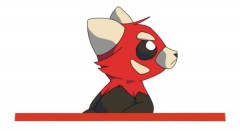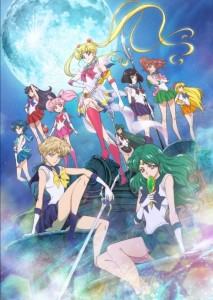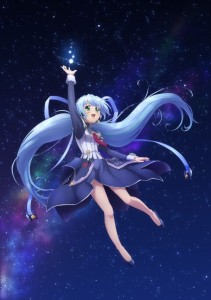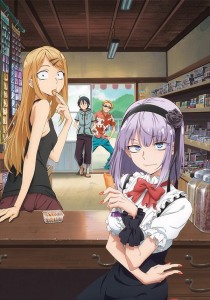![Log Horizon 2 Collection 1 Blu-ray Front Cover]() Slowly pulling the curtain back on the larger world.
Slowly pulling the curtain back on the larger world.
What They Say:
Having cleared the Abyssal Shaft, the members of the raiding party have returned to Akihabara to consider their next options. First, though, there’s an unexpected lesson in history as the founder of the Debauchery Tea Party, the legendary Kanami, resurfaces with an extremely peculiar entourage and some even more stunning revelations about connections to the outside. But the ramifications of this will have to wait. With new political situations brewing between the Guilds,
Shiroe sets Isaac to the task of training Maihama’s knights while the younger members of Log Horizon are sent out on what should be a simple quest. Collecting the materials required to make a magic bag, however, becomes much more difficult when ogres and nightshades get involved! Fortunately, the junior team is about to get a jolt of fresh blood… in the form of a Vampire! The action escalates and the world gets even wilder in the second thundering collection of LOG HORIZON – SEASON 2!
Log Horizon 2 Collection 2 contains episodes 14-25.
The Review:
Audio:
The audio presentation for this release brings us the original Japanese language track and the new English language dub in stereo encoded using the DTS-HD MA lossless codec. The show is one that uses the forward soundstage well enough with its mix of magic, science and dialogue to convey a pretty decent balance of material as the characters interact. There’s a good full feeling when it’s all about the non-spoken dialogue while the placement throughout the rest of the dialogue is certainly well handled and properly set so that multiple characters on the screen feel like they’re where they’re supposed to be. There isn’t a lot of action in the show but we do get a few sequences of it here and it’s definitely a lot of fun with the way it goes in a kind of big way without being overblown or too dramatic. The opening and closing sequences are naturally the bigger areas in terms of music and having the strongest design, but dialogue is well done throughout and we didn’t have any problems with dropouts or distortions during regular playback.
Video:
Originally airing in the fall of 2014, the transfer for this TV series is presented in its original aspect ratio of 1.78:1 in 1080p using the AVC codec. The twelve episodes of this half of the series are spread across two discs in a nine/three format. Animated by Studio Deen, the series has a good range of detail about it in both the backgrounds with the world setting and the character designs and the virtual aspects that essentially keeps to the tone and style of what Satelight produced in the first season. There’s a good bit of color to the show in general with a lot of variety, but also a lot of shades of green for all the overgrowth that’s definitely got a lot of appeal. The show isn’t huge with detail when you get down to it, but we do get some good designs for the characters that make them all individual and with more than just simple outfits while the backgrounds are nicely lived in. Colors are strong and solid throughout and it has a very rich look when you get down to it.
Packaging:
The packaging design for this release definitely plays to the world design side of things as we get a pretty busy but also pretty colorful and appealing front cover with a lot of natural aspects in the background, decay and growth, as well as a nod to some of the more primary characters of this set in the foreground lined up. The back cover goes with a different design than the first season where it works the angled approach with darker background colors as we get a solid summary of the premise and a slew of shots from the show in small form. The disc and episode count is clearly listed as are the basic extras that we get here. The bottom has the standard design layout with the production credits and the technical grid that lays it all out cleanly and clearly in an easy enough to read format even with the small font. No show related inserts are included nor is there a reversible cover.
Menu:
The menu design is another odd choice piece, though one that certainly does work in a very good way. The layout for it goes in a very earth-natural kind of way where the navigation strip along the right is just a slightly curved piece that uses black for the breakout of episodes by title while the left side of it has the numbers in blue/green, the text for all of it in white. It has a very natural feeling to it that works well, especially with the first menu screen that has a larger and expanded background piece from the show itself with the building with the beautiful but creepy overgrowth on the modern builds design. The logo is kept to the left in the middle and there’s no character artwork, which is a little unusual but I really like the backgrounds here so I can’t complain. Navigation is fairly standard overall with no real deviations outside of a little stylistic point here and there so it’s easy to navigate and everything loads quickly and smoothly from the top level and as a pop-up menu.
Extras:
The only extras included in this release are the clean versions of the opening and closing sequences.
Content: (please note that content portions of a review may contain spoilers)
The second season of Log Horizon draws to a close here with the final twelve episodes. Episodes that in the end leave you wanting more even if you feel somewhat unfulfilled by what’s given here overall. One of the things that i do find appealing about the property as it goes further and further with the story is that there is a big picture storyline that’s slowly coming into view. It doesn’t have an on the fly kind of feel to it so you become invested in the smaller moments. The problem, of course, is that the anime covers only so much .Thankfully, Yen Press is releasing the light novels so there’s an option there for those that want to explore more of it. This season takes its time in giving us some of that big picture material and nowhere near enough of it, but it is enough to tantalize and make you want more.
Admittedly, a decent chunk of this half of the season left me cool to it, more so than the first half which had its own problems in pacing and quality of material it wanted to explore as it adapts those novels. One of the bigger focuses here is that we get some of the younger set of characters like Rudy and Izuzu, where they’re being given quests to go on together as a group that’s designed to help them grow and become better at handling the world and all its experiences and personalities. With Nyan-ta watching from afar in order to make sure they’re not in any serious trouble they can’t handle, it’s a decent enough time in watching them learn more about the world that lets us discover new things. At the same time, I really find these characters fairly dull and uninteresting compared to the adults that populated most of the first season and that just makes this uninteresting overall as it moves through far too familiar story ideas and character growth material.
![log-horizon-2-episode-14a]()
![log-horizon-2-episode-14]()
![log-horizon-2-episode-15]()
![log-horizon-2-episode-16]()
What is interesting in their journey is that they come across a woman that’s named Roe2, or Shiroette, as she really is essentially a female version of Shiroe that’s on her own journey. We get a bit more about who she is later in the season when she sends a letter to Shiroe as it makes it clear that there are those like the Adventurers that have gotten stuck here themselves from elsewhere, naming her type Travelers and the others Collector’s as they look for empathy. It’s an interesting angle to take and it kind of weirdly expands the narrative because you have to wonder who they are and where they all come from, leading you to “aliens” surprisingly quickly, depending on your point of view. Shiroette is frustrating to watch though because it’s all about the cliches of being a genderbent version of Shiroe as she retains a good chunk of his memories while her own quirk is that she wants to be called Big Sister by the gang. I like the potential of what this new group represents, but it’s almost just weirdly shoehorned in along the way here.
A lot of the smaller parts of the season are interesting, though again it tends to avoid using a lot of the more regular characters and instead digs into some of the side characters. Which is good, because you want a properly expansive cast, but at the same time it just separates us further from those that defined it early on. Some of what I liked ended up involving Isaac as we see Shiroe assigning him the task of teaching some of the People of the Land to fight, as there are rumblings across the landscape of war brewing among these groups, and he’s intent on just leveling them up and doing no more than that. That it actually requires real training and connection is a nice touch because these NPC characters aren’t “human” controlled in the same way and don’t have the external stimuli to connect with from their lives to handle actual gaming combat. It’s a nice reminder of how the People of the Land are different and how they have to be worked with in a separate way.
The set also digs into some guild business, such as seeing the problems Harmony is going through with a large base of members that don’t do anything or contribute, as well as exploring the problem of income inequality through the Round Table Conference. There are some neat real world issues brought into the show as we’ve seen in the past when it comes to managing Akihabara and the larger world itself and I like that there are options given here but nobody can agree on the best course of action to follow. It’s these little areas that made the first season so interesting for me and it’s been the area where things are weaker this season. We saw a bit more of this in the first half of this season when it came to the idea of where the gold and treasure monsters have come from, so looking into how to deal with players that are not exceptional with adventuring skills are dealing with becoming less important to the realm has its moments. Basic incomes are brought up as well as wealth redistribution alongside ways of expanding and opening up craft skillsets that in turn would styme innovation.
![log-horizon-2-episode-17]()
![log-horizon-2-episode-18a]()
![log-horizon-2-episode-25a]()
![log-horizon-2-episode-21]()
The show does go bigger toward the end of the season with the action as there’s a new threat that has arrived which seemingly only impacts People of the Land. It comes at the same time that Shiroe is learning more from Roe2 about the moon and what people are there and how it all ties to the possibility of getting back to the “old world” that so many crave as they narrow in on being here for just about a year in realtime. There are interesting ideas at play here with the ways player deaths work and are connected to the moon, but mostly the end arc is about the action and a light nod toward Kanami as she’s over on the China server getting her game on, bringing another piece of Shiroe’s past to light and giving us a new side of him to look at. It’s all good stuff but it’s just so weirdly paced and coming at us in such a rush that it lacks a kind of resonance that makes it work.
In Summary:
While this half of the season didn’t do much for me I’m still hoping that we get a third season to explore more of this world and what it is that’s going on here. The show has some good stuff going for it as I like the way it digs into social and political aspects and the deep connection to economics and security. But these issues feel like they take more of a backseat this time around, especially for the journey that they kids are on, and it becomes less interesting because of that. But also because we get a lot less of the core main characters in general as only Shiroe really has a role of any note in this and even that’s pretty reduced. While this isn’t the best way to bring the season to a close it does hit a lot of material and opens up the possibilities even more, so I’m pretty hopeful though a little guarded about the real chances for more.
Features:
Japanese DTS-HD MA 2.0 Language, English DTS-HD MA 2.0 Language, English Subtitles, Clean Opening, Clean Closing
Content Grade: C+
Audio Grade: B+
Video Grade: A-
Packaging Grade: B
Menu Grade: B
Extras Grade: B-
Released By: Sentai Filmworks
Release Date: July 26th, 2016
MSRP: $69.98
Running Time: 300 Minutes
Video Encoding: 1080p AVC
Aspect Ratio: 1.78:1 Widescreen
Review Equipment:
Sony KDL70R550A 70″ LED 1080P HDTV, Sony PlayStation3 Blu-ray player via HDMI set to 1080p, Onkyo TX-SR605 Receiver and Panasonic SB-TP20S Multi-Channel Speaker System With 100-Watt Subwoofer.
 While we look at the numbers weekly and some of the second-week additions, it’s definitely worth taking a look at how things stack up over the course of a month. While these obviously aren’t final numbers as books tend to eke out a couple thousand copies here and there at times for various reasons, it’s definitely a good way to get an idea of how books are performing. The big winner for June is Hunter x Hunter on the manga side as it hit 1.1 million copies moved. And there’s still enough material before the hiatus for another volume to come. The closest book behind it is Assassination Classroom and it’s just over 300,000 volumes difference. There’s a bit more competition further down the chart but we’re glad to see both Drifters and D.Gray-man getting some additional attention while also getting a handle on how both Tokyo Ghoul:re and One-Punch Man are doing. We’re also seeing slow but steady growth trends for My Hero Academia including a lot of previous volumes bumping up nicely.
While we look at the numbers weekly and some of the second-week additions, it’s definitely worth taking a look at how things stack up over the course of a month. While these obviously aren’t final numbers as books tend to eke out a couple thousand copies here and there at times for various reasons, it’s definitely a good way to get an idea of how books are performing. The big winner for June is Hunter x Hunter on the manga side as it hit 1.1 million copies moved. And there’s still enough material before the hiatus for another volume to come. The closest book behind it is Assassination Classroom and it’s just over 300,000 volumes difference. There’s a bit more competition further down the chart but we’re glad to see both Drifters and D.Gray-man getting some additional attention while also getting a handle on how both Tokyo Ghoul:re and One-Punch Man are doing. We’re also seeing slow but steady growth trends for My Hero Academia including a lot of previous volumes bumping up nicely.




























































